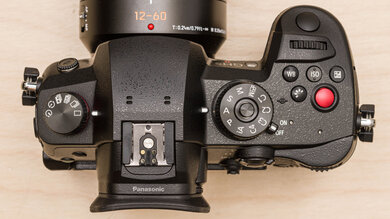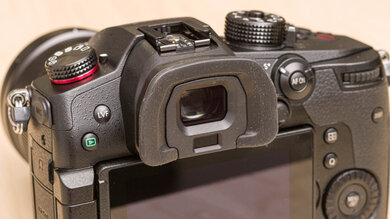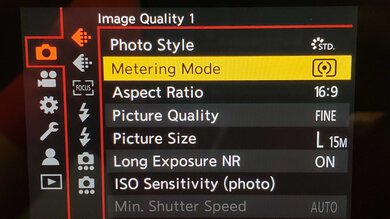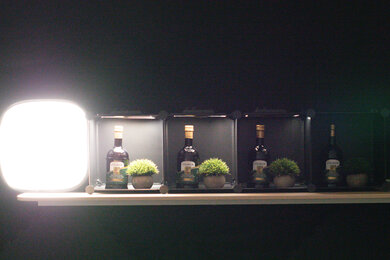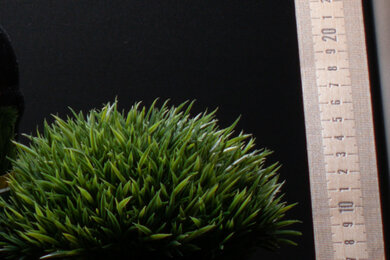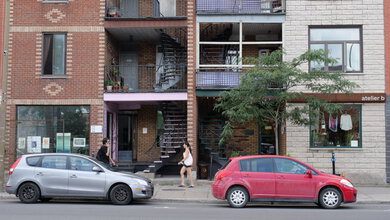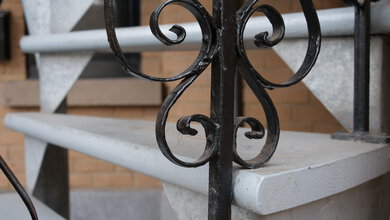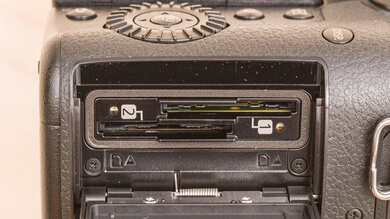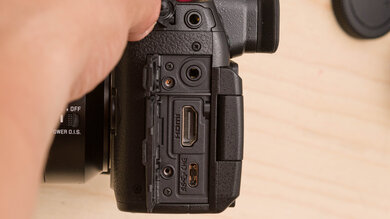The Panasonic LUMIX GH5 II is a video-oriented Micro Four Thirds mirrorless camera. It's a refreshed version of the popular Panasonic GH5, the most notable improvement being its ability to record 10-bit 4:2:0 4k 60p video. The GH5 II offers many video features, including a wide array of recording formats and codecs and plenty of frame rate options, including 4k and FHD recording at up to 60 fps. It has a full set of inputs and outputs, including a full-size HDMI port with clean HDMI output to connect an external recorder without overlays and microphone and headphone jacks. It has in-body image stabilization and good overall video quality, though its low-light performance is noticeably worse due to its smaller sensor. It's also suitable for still photography with excellent JPEG image quality; however, its RAW noise handling capability is only decent. Unfortunately, its autofocus system also lags a bit behind some of its competitors.
Our Verdict
The Panasonic GH5 II is decent for travel photography. It delivers great overall image quality with good dynamic range and fair noise handling capability at higher ISO levels, though it isn't the best option for low-light shooting. It also feels very well-built and comfortable to use. It has an excellent battery life, which should last you throughout the day, though this can vary drastically depending on real-world conditions and usage habits. That said, its autofocus system is only decent, and the camera is bulky and heavy.
- Great overall image quality.
- Feels well-built and comfortable to use.
- Excellent battery life.
- Autofocus is only decent.
- On the bulkier side.
The Panasonic GH5 II is good for landscape photography. Its sensor has fair RAW noise handling capability in low light but delivers excellent overall image quality for its class. It also has good dynamic range to bring out a fairly wide array of detail in landscape shots. It feels well-built and incredibly comfortable to use. However, it's heavy and bulky, so it isn't the most convenient to take to remote shooting locations.
- Good dynamic range.
- Great overall image quality.
- Feels well-built and comfortable to use.
- On the bulkier side.
The Panasonic GH5 II is good for sport and wildlife photography. While its regular max burst rate is just okay, it also offers 4k and 6k burst photo modes that can effectively capture images at 30 or 60 fps in 4k and 30 fps in 6k, so you can capture specific moments of high-speed action. Image quality is great for its class, and the camera feels incredibly comfortable to use. However, its autofocus system is only decent at tracking moving subjects.
- Great overall image quality.
- Feels well-built and comfortable to use.
- 4k and 6k burst photo modes for 60 and 30 fps stills.
- Autofocus is only decent.
- On the bulkier side.
The Panasonic GH5 II has decent RAW photo performance. Its sensor has good dynamic range, so it can capture a fairly wide range of highlight and shadow detail. Images also look quite sharp and detailed. However, its noise handling is just okay, so it isn't the best option for low-light shooting, though you can mitigate noise by shooting at a slower shutter speed or wider aperture.
- Good dynamic range.
- Noise handling is just okay.
The Panasonic GH5 II is okay for vlogging. It has a sturdy fully-articulated screen, so you can easily turn it to face you and monitor yourself while recording. It also has an excellent battery life and in-body image stabilization, which does a great job of reducing camera shake in FHD when walking at a moderate pace, and a decent job in 4k. Overall, the video quality is good, and it doesn't have a recording time limit. However, it's heavy and bulky, making it hard to carry around for long periods. Its autofocus system is also underwhelming.
- Good overall video quality.
- Remarkable internal recording capability.
- Wide array of inputs and outputs.
- Autofocus is only decent.
- Video quality is a bit worse in low light.
- On the bulkier side.
The Panasonic GH5 II is excellent for studio video work. It delivers good overall video quality in 4k and has fantastic internal recording capability, with the ability to record 10-bit 4:2:0 4k footage at up to 60 fps. It also offers a ton of different video recording formats and file sizes. Its menu system is well laid out, and the camera has a full set of inputs and outputs to connect an auxiliary microphone, headphones, or an external HDMI recorder. Its autofocus system is only satisfactory, and its low-light performance is a bit worse due to its smaller sensor.
- Good overall video quality.
- Remarkable internal recording capability.
- Wide array of inputs and outputs.
- Offers many recording formats for video.
- Autofocus is only decent.
- Video quality is a bit worse in low light.
The Panasonic GH5 II is a poor choice for action video. It's not designed to be mounted on a helmet or chest rig, and it's not waterproof, although we don't currently test for this. It does a good job of stabilizing video when shooting handheld, but it can't record at frame rates higher than 60 fps, so it's not well-suited to generating slow-motion footage of high-speed action. It's also on the bulkier side.
- Good overall video quality.
- Feels well-built and comfortable to use.
- Video quality is a bit worse in low light.
- Not suitable for action camera mounts.
- Not waterproof.
- On the bulkier side.
Changelog
- Updated Feb 12, 2024: Added a link to the Panasonic LUMIX GH6 in the 4k Video Frame Rate section.
- Updated Jan 29, 2024: Added text to the 'Raw Photo Performance' verdict box and updated existing verdict boxes for clarity and accuracy.
- Updated Jan 29, 2024: Converted to Test Bench 0.12.1.
- Updated Apr 24, 2023: Converted to Test Bench 0.12.
Check Price
Differences Between Sizes And Variants
The Panasonic LUMIX GH5 II comes in one color variant: 'Black'. You can purchase the camera body alone or in a bundle with the LUMIX Leica DG H-ES12060 12-60mm f/2.8-4.0 Vario-Elmarit ASPH Power O.I.S. lens.
If you come across another variant or your Panasonic LUMIX GH5 II doesn't correspond to our review, let us know, so we can update the review.
You can see our unit's label here.
Popular Camera Comparisons
The Panasonic LUMIX G9 II is better overall than the Panasonic LUMIX GH5 II. It has a higher-resolution sensor and newer processor, with faster burst shooting and a more reliable phase-detection autofocus system, making it more well-rounded. Also, while it's marketed as a stills-oriented camera, its video specs are on par with, and in some ways even surpass, the more video-oriented GH5 II.
The Panasonic LUMIX GH5 II and the Olympus OM-D E-M1 Mark III are both great Micro Four Thirds cameras, but they're suited to different uses. The Panasonic offers more advanced video features, including more 4k frame rate options, more file format and codec options, and better internal recording capability. If you're more of a photographer or hybrid shooter, the Olympus is more well-rounded, with a high-resolution photo mode, faster burst shooting, and a slightly more reliable autofocus system.
The Sony α6600 and the Panasonic LUMIX GH5 II use different-sized sensors and are suited to different uses. The Panasonic is a Micro Four Thirds camera with more frame rate options and better internal video recording capability than the Sony, so it's a good option for studio video or amateur filmmaking. That said, the Sony camera has a more effective autofocus system, a longer battery life, and delivers better image quality and low-light performance thanks to its larger APS-C sensor.
The Panasonic LUMIX GH5 II and the Panasonic LUMIX GH5s are similar cameras and are fantastic video options. The biggest difference between them is the sensor; the GH5 II has a 20.3 MP sensor while the GH5s has a multi-aspect 10.2 MP sensor that's optimized for low light. If you mainly shoot video, and you want better low-light performance, you can't go wrong with the GH5s. However, if you're more of a hybrid shooter, the GH5 II is a bit more well-rounded with built-in stabilization for handheld shooting and an improved autofocus system, along with anamorphic 6k video recording.
Test Results

You can see the camera with its kit lens here and with the lens extended to its farthest point here. If you're looking for something a little more portable, consider the OM SYSTEM OM-1.
- Metal and plastic body
- Buttons provide good tactile feedback
- Screen can rotate to be seen from the front
- SD card slot is covered by an easily accessible hinged door
- Inputs and outputs are covered by hinged rubber flaps
- Screen hinge mechanism feels very sturdy
- Some physical controls like the thumb stick and dials don't feel as premium than those on the Panasonic LUMIX DC-S5
- Handgrip is large enough for most hand sizes and has a textured rubber surface that provides a secure hold
- Changing aperture, shutter speed, and ISO is easy with either eye pressed up against the viewfinder thanks to the dedicated controls for exposure adjustment functions
- All essential functions can be reached with your thumb
- Rubber eyecup is comfortable
- Body is more rounded than the Panasonic LUMIX DC-S5, giving it a slightly more comfortable feel, although the grip is a bit narrower
- Interface is well laid-out and can be navigated via the touchscreen, the command dials, or the joystick
- Some video settings are buried within the video menu, but once you get used to it, it's easy to find what you're looking for
- Guide mode provides more information about certain features and camera functions
Note: In 'Creative Video Mode', the max ISO is 12800.
Note: Panasonic advertises that this camera's battery life goes up to approximately 410 photos when used with the Panasonic LUMIX G Vario 12-60mm f/3.5-5.6 H-FS12060 lens.
Note: In addition to its regular continuous shooting modes, the GH5 II also offers '4k PHOTO' and '6k PHOTO' burst modes, which essentially record clips of video from which you can save high-quality stills. The '4k PHOTO' mode can capture bursts of either 30 fps or 60 fps, while '6k PHOTO' captures bursts of 30 fps.
If you want a Micro Four Thirds camera with a faster continuous shooting speed, check out the Olympus OM-D E-M1 Mark III.
If you want a camera with better RAW noise handling, check out the Panasonic LUMIX GH5s.
Note: This camera has a couple of useful settings called 'Sound Rec Gain Level' and 'Sound Rec Level Adj' to help you easily adjust microphone gain levels as you shoot.
Note: The Panasonic LUMIX GH5 II has many recording format options and codecs, which are adjustable via the 'Rec Quality' tab in the 'Image Format' video menu. According to Panasonic, it can record using the following codecs for each format:
- MOV: H.264/MPEG-4 AVC, H.265/HEVC (Audio format: LPCM (2ch 48kHz/16-bit, 48kHz/24-bit*, 96kHz/24-bit*) *When attaching DMW-XLR1 (sold separately)
- MP4: H.264/MPEG-4 AVC, H.265/HEVC (Audio format: AAC (2ch))
You can see all of the MP4 menu options here and here, and all of the MOV menu options here, here, and here.
If you need a camera that can record 4k video at 120 fps, consider the Panasonic LUMIX GH6.
Note: The bit rates for this camera vary depending on what recording format you shoot in. For instance, the max bit rate in MOV is 400 Mbps and the minimum bit rate is 95 Mbps. Chroma 4:2:2 is also only available in MOV format.
Note: The bit rates for this camera vary depending on what recording format you shoot in. For instance, the max bit rate in MOV is 200 Mbps, and the minimum bit rate is 92 Mbps. Chroma 4:2:2 is also only available in MOV format.
Note: You can see the rest of the inputs on the other side of the camera here. Also, this camera allows direct streaming to various platforms via Wi-Fi, though we don't currently test this feature.



